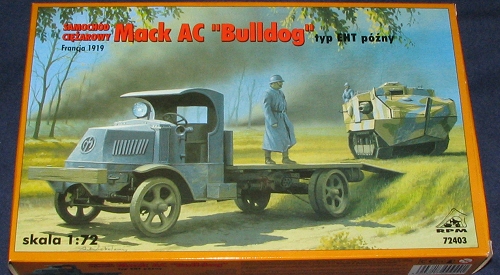
| KIT: | RPM 1/72 Mack AC 'Bulldog' type EHT |
| KIT #: | 72403 |
| PRICE: | $14.98 (13.46 at Squadron) |
| DECALS: | Several options |
| REVIEWER: | Scott Van Aken |
| NOTES: |

| HISTORY |
The Mack AB was the company's first standardized, high-volume model series, introduced in 1914. The first ABs had chain drive or worm drive.
The AC model was introduced in 1916. It is credited with giving Mack its famous Bulldog identity. The story goes that the British engineers testing ACs and the Tommies (British soldiers) in France said that "the Mack ACs have the tenacity of a bulldog." At that time, the symbol of Great Britain was the bulldog, and this was high praise for the trucks. In 1922, the company adopted the Bulldog as its corporate symbol.
During World War I, Mack delivered approximately 4,500 AC model trucks of 3 11/42-, 5 11/42-, and 7 11/42-ton capacity to the U.S. government and more than 2,000 units to Great Britain. In 1920, a dual reduction drive was added.
| THE KIT |
 Since
all of the recent kits of the early Mack Truck are basically the same, I'll
be doing a bit of repeating.
Since
all of the recent kits of the early Mack Truck are basically the same, I'll
be doing a bit of repeating.
There are two sprues and what seems like a lot of parts. The parts themselves are well molded and there was a bit of flash on one of the sprues. Nothing to worry about. Ejector pin marks can be found on one side of the larger parts. In the case of this vehicle, that will only really affect the bed parts, particularly the outside of the vertical parts. The ones inside the tail gate will be near impossible to remove and you'll take off detail removing the ones on the front and sides. But since they are visible, you'll have no choice. The ones inside the cab sides will be a breeze to remove. The inside of the bed canvas has huge ejector towers, as you can see in the image. Since the back area is open, you'll need to remove them. The wooden planked areas also have sink areas on them opposite the stakes. It feels like a washboard when you run your fingers over it. Break out the filler if you don't plan on having the bed full of stuff; same goes for the vertical panels. The kit provides a complete drive train; engine, drive shaft, rear end, and exhaust. There is also complete steering mechanisms provided though this is inoperable. In all a most complete model. Unlike the previous kit, this one has a bit different front end in that the engine cooling area is of a slightly different design. This is the simplest of the four boxings with naught but a flat bed so you won't have to sweat the sink areas on the vertical panels!
 Instructions are very well
done with 37 easy to understand construction sequences. No color
information is provided during construction. All that is on the back of the
box, providing only Humbrol color reference numbers. Once again, a company
that won't provide generic names for the colors. Fortunately, the color
profiles provided are well done so one should be able to figure out most of
what is there. It looks like dark grey running gear with OD green bodywork.
Several options are given. The small decal sheet is fairly well
printed and very glossy with the clear carrier connecting a number of the
decals together so you'll have to cut them away to be sure not to pull off
half the sheet! This sheet is exactly the same in all the kits. In fact,
the only difference is in the first page, where the decaling options are
given and the last page of the instruction sheet where you decide what goes
on the nose or the bed of the truck.
Instructions are very well
done with 37 easy to understand construction sequences. No color
information is provided during construction. All that is on the back of the
box, providing only Humbrol color reference numbers. Once again, a company
that won't provide generic names for the colors. Fortunately, the color
profiles provided are well done so one should be able to figure out most of
what is there. It looks like dark grey running gear with OD green bodywork.
Several options are given. The small decal sheet is fairly well
printed and very glossy with the clear carrier connecting a number of the
decals together so you'll have to cut them away to be sure not to pull off
half the sheet! This sheet is exactly the same in all the kits. In fact,
the only difference is in the first page, where the decaling options are
given and the last page of the instruction sheet where you decide what goes
on the nose or the bed of the truck.
| CONCLUSIONS |
Overall a very nice kit that is marred only by the sink areas and ejector pin marks where they will be difficult to completely eradicate. Construction should be straight-forward and I have to applaud RPM for delving into the very early history of military motorized transport.
April 2005
| REFERENCES |
The internet.
You can find this kit and many others at

If you would like your product reviewed fairly and quickly by a site that has around 300,000 visitors a month, please contact me or see other details in the Note to Contributors.